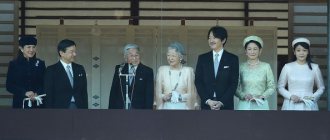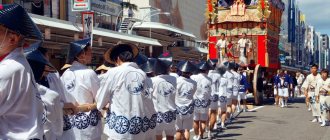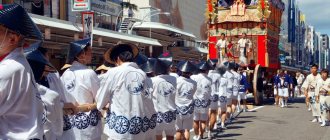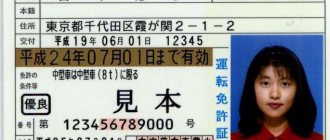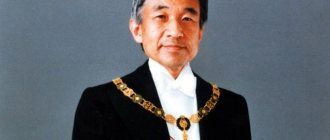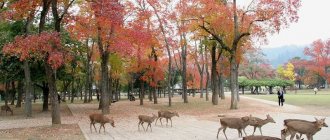A special law passed in June 2021, amending the Imperial Household Law to allow for the abdication of Emperor Akihito (now Emperor Emeritus), called on the government to consider a stable succession to the imperial title. The law of the imperial house states that only a descendant of emperors in the male line can inherit the throne - thus, at the moment, only three can inherit the title of emperor - Prince Akishino, his son Prince Hisahito and Prince Hitachi (the younger brother of the previous emperor and uncle of the current one).
Under the current system, if Prince Hisahito ascends the throne and has no sons, then there will be no one to inherit the imperial title. Given this situation, the additional resolution calls for consideration of measures for a stable succession to the throne. It was planned to begin discussing the issue after the Rikkoshi no rei ceremony, during which the appointment of Prince Akishinomiya as crown prince is officially announced to the people of the country and people outside it. However, due to the new coronavirus pandemic sweeping the world, the ceremony planned for April 19 had to be postponed, and consideration of the issue of inheriting the throne is still up in the air.
In ancient times, inheritance was not limited to the principle of inheritance by men and through the male line, and there were ten reigns of empresses - in two cases, a woman assumed the imperial title twice. Here we will present women on the Japanese imperial throne, based on the materials of the expert commission on the Imperial Household Law of 2005, which worked under the cabinet of Koizumi Junichiro. They all descend from emperors in the male line.
Ten Reigns of Eight Empresses
| Women on the Imperial Throne of Japan (reign years) | Male ancestor | Status before taking the imperial title |
| 33 Empress Suiko (592-628) | 29 Emperor Kimmei | Emperor's consort |
| 35 Empress Kogyoku (642-645) ★ | 30 Emperor Bidatsu | Emperor's consort |
| 37 Empress Saimei (655-661) ★ | Former Empress | |
| 41 Empress Jito (690-697) | 38 Emperor Tenchi | Emperor's consort |
| 43 Empress Genmei (707-715) | 38 Emperor Tenchi | Crown Princess |
| 44 Empress Gensho (715-724) | 40 Emperor Tenmu | Princess |
| 46 Empress Koken (749-758) ☆ | 45 Emperor Shomu | Crown Princess |
| 48 Empress Shotoku (764-770) ☆ | Former Empress | |
| 109 Empress Meisho (1629-1643) | 108 Emperor Gomizunoo | Princess |
| 117 Empress Go-Sakuramachi (1762-1770) | 115 Emperor Sakuramachi | Princess |
Created based on materials from the expert commission on the Law on the Imperial Household; the signs ★ and ☆ mark women who twice took the imperial title in front of the name of the empresses - the serial number in the list of reigns of the emperors of Japan
Next, we present the circumstances of the ascension to the throne of the empresses, using the materials of the expert commission on the Law on the Imperial House.
Empress Suiko (33)
Daughter of the 29th Emperor Kimmei, wife of the 30th Emperor Bidatsu
The 32nd Emperor Shuxiong was assassinated by the powerful courtier Soga Umako during political disputes. Several male candidates could lay claim to the imperial title, but due to Umako's intrigues it was impossible to settle on any one of them, and Empress Suiko was chosen to strengthen ties between the Soga clan and the imperial house, as well as for the purpose of political stabilization.
After her, Jomei, the grandson of Emperor Bidatsu, became the 34th emperor.
Japanese etiquette: ancient traditions and modern rulesElena Gavrilina-Fujiyama, 2021
2.5. Abdication of Emperor Akihito
On December 1, 2021, Japanese Prime Minister Shinzo Abe announced that the abdication ceremony of the current emperor would take place on April 30, 2021, and that the throne would pass to his eldest son, Crown Prince Naruhito, on May 1, 2021.
There have already been similar examples in Japanese history: 58 emperors abdicated the throne for one reason or another. On May 7, 1817, Emperor Kokaku, the 119th Emperor of Japan, handed over the throne to his son, Emperor Ninko, accepting the honorary title of Daijō tenno (literally, Emperor who ceded the throne, or Emperor Emeritus). By the way, after retiring, Emperor Kokaku began to study and further develop palace ceremonial etiquette. And so, 200 years later, the honorary title of daijo tenno was accepted by the beloved Emperor Akihito.
In August 2021, the 125th Emperor of Japan, Akihito, announced his intention to abdicate in an address to the nation due to his advanced age and health conditions. The country knew that in February 2021 the emperor underwent heart surgery and had recently been battling cancer. In his rare public appearances in 2021, he has already expressed fears that age and deteriorating health could prevent him from performing his duties to his full potential. On December 23, 2021, the emperor turned 85 years old.
Gradually over the course of two years, Emperor Akihito handed over the reins of power to Crown Prince Naruhito, who was groomed from his youth for high service for the benefit of Japan.
The abdication of the current emperor and the accession to the throne of his successor are important events not only historically, but also in protocol terms. They involve holding many ceremonial, ritual and protocol events, some of which we will try to tell you about.
On January 2, 2021, Emperor Akihito, together with his wife, Empress Michiko, and other members of the imperial house, went out onto the balcony of the Imperial Palace in Tokyo and addressed the people with a congratulatory speech on the occasion of the New Year. Since 1948, such a ceremony has been held twice a year - on the emperor’s birthday (a national holiday in Japan) and on New Year’s. 2021 saw a record number of visitors - more than 150,000 people. Emperor Akihito came out to greet the crowd seven times instead of the traditional five. In his speech, he expressed hope that the coming year will be happy for as many people as possible. “I pray for peace and happiness for our country and the whole world... I am sincerely glad to celebrate the New Year with all of you under this cloudless sky,” the emperor said.
January 7, 2021 marks the 30th anniversary of the death of Emperor Hirohito and the accession of Emperor Akihito to the throne. It was on this day in 1989 that the Showa era ended and the Heisei era began.
On February 24, 2021, a ceremony organized by the Japanese government for the general public to celebrate the 30th anniversary of Emperor Akihito's enthronement was held at the National Theater in Tokyo. More than 8,000 people, including members of parliament, ministers, public and political figures, famous athletes, and cultural representatives, greeted the emperor. In his response speech, the emperor thanked his people for their support throughout his reign. He also called on the Japanese to be more open to global trends: “I think that in the context of growing globalization, we should open up more to the outside world, use its wisdom and strength to develop our own position and build relationships with other countries.”
On March 12, 2021, an important ritual and ceremonial event (“Kashikodokoro ni Taii Oyobi Sonno Kijitsu Hokoku no Gi”) took place at the Imperial Palace in Tokyo, the first in a series of abdication procedures. During it, the emperor informs the deities of his intention to renounce the imperial title, as well as the date of renunciation. The ceremony was attended by Crown Prince Naruhito, Prince Akishino, employees of the Imperial Household Administration and security services - about 40 people in total.
At 10 o'clock in the morning, Emperor Akihito, dressed in the traditional costume "korozen no goho", entered Kashikodokoro - the shrine of the founder of the imperial family, the goddess Amaterasu. There, the emperor read o-tsugebumi - “notice”, which spoke of the abdication and the date of its implementation - April 30, 2021. The emperor then repeated this rite at the Koreiden Shrine, erected in honor of the ancestors of the imperial house, and at the Shinden Shrine, where all the Shinto deities of Japan are venerated.
Next, according to tradition, a ceremony was held to send special envoys to the tombs of Empress Jingu and Emperor Jimmu, as well as the four previous emperors (Emperor Komei, reigned 1846–1867; Emperor Meiji, 1867–1912; Emperor Taisho, 1912–1926; Emperor Showa, 1926–1989). This ceremony was called “Jingu-Jimmu tenno sanryo oyobi ni tekushi hakken no gi.”
Shinto ritual activities continued in April.
On April 18, a ritual ceremony (“Shinetsu no gi”) took place at the main Shinto shrine, Ise-jingu. The Emperor and Empress arrived in Ise; this was their fifth pilgrimage since Emperor Akihito's accession to the throne in 1989. Two sacred regalia were brought from Tokyo - a sword (Kusanagi no Tsurugi) and a necklace with precious jasper (Yasakani no Magatama). The third sacred regalia - the mirror (Yata no kagami), as already mentioned, is constantly located in the Ise-jingu temple.
At 10.45, Emperor Akihito arrived at the temple. Passing through the outer torii gate, he entered the main shrine. He was followed by the chief imperial master of ceremonies and the priestess - the manager of rituals at the Ise-jingu temple, she is the daughter of Emperor Akihito Kuroda Sayako. Two chamberlains brought in the sacred sword and jasper. The emperor then worshiped the goddess and handed over to the attendants a "precious branch" (a branch of the Shinto sacred sakaki tree with paper strips attached), which was respectfully presented to the goddess.
After a pilgrimage to Ise-jingu Temple, Emperor Akihito and Empress Michiko visited the imperial shrine in Tokyo's Musashino district on April 23. After worshiping at the tomb of Emperor Showa, Emperor Akihito officially informed his father of his abdication and performed the Shinto ritual "Shinetsu no ni".
On April 30, 2021, the 125th Emperor of Japan, Akihito, officially ended his tenure on the throne.
According to tradition, several more ritual ceremonies took place on this day.
In the morning, Emperor Akihito, in the presence of 50 people, again visited all three Shinto shrines in the imperial palace and informed the gods about the renunciation that had taken place.
At 17.00, the official abdication ceremony (“Taiirei-seiden no gi”) took place in the palace, which was attended by about 300 people, including, in addition to members of the imperial house and palace employees, representatives of all three branches of secular power.
At the beginning of the ceremony, the sacred regalia, as well as the personal seal of the emperor and the state seal of Japan, were brought into the hall.
Then Prime Minister of Japan Shinzo Abe spoke on behalf of the people of the country and expressed gratitude for 30 years of impeccable fulfillment of imperial duty. In his last public speech as Emperor of Japan, His Majesty said: “Since taking the throne 30 years ago, I have carried out my duties as Emperor with a deep sense of trust and respect for the people. If I succeeded, then I can consider myself a happy person. I sincerely thank the people who accepted and supported me in the performance of my constitutional duties. The Empress and I sincerely wish that the Reiwa era, which begins tomorrow, will be stable and fruitful. I pray with all my heart for peace and happiness for all people in Japan and around the world."
On April 30, the Heisei era ended. As of May 1, 2021, Emperor Akihito bears the title "Emperor Emeritus." The residence of Honorary Emperor Akihito and Honorary Empress Michiko became the Togu Palace on the Akasaka estate on the territory of the imperial palace.
Empress Jito (41)
Daughter of the 38th Emperor, Tenchi, wife of the 40th Emperor, Tenmu.
The most likely contender for the imperial title was Prince Kusakabe, born in marriage to Emperor Tenmu, but Prince Otsu, his half-brother, also had influence. A conflict at court between supporters of the two princes prevented the quick selection of a successor, and Prince Kusakabe soon died. The prince had an infant son, Prince Karu, Jito's grandson, and she took the title in order to later pass it on to the prince, who became Emperor Mommu (42nd Emperor).
After her, Emperor Mommu ruled.
Meiji Scroll Tiara
Empress Shōken (left), Empress Teimei (right)
One of the oldest (possibly the oldest) tiaras currently in use by the Japanese imperial family. It consists of a base of curls, which are crowned with a row of round diamonds. These individual diamonds can be removed and the tiara used without them (as seen in the Kōjun Empress photo) or mounted with a diamond star in the center (as seen in the Shōken Empress photo).
Empress Kōjun
This tiara is said to be made by Chaumet and dates back to 1885, and indeed it can be seen on the head of every empress in the modern era, starting with the Shōken Empress. Shuken (1849-1914) was the wife of Emperor Meiji, who reigned from 1867 to 1912. During the Meiji era, Japan became more open to Western influences, from which it borrowed many things, including types of jewelry such as tiaras, which were not part of traditional Japanese attire.
The tiara has been passed down to every reigning empress since Meiji times. It was worn by Empress Temii (1884-1951), wife of Emperor Taishu, and later by Empress Xiong (1903-2000), wife of Emperor Shuwa (also known as Emperor Hirohito, the former emperor). Today it is worn by Empress Michiko, wife of the current Emperor Akihito.
Just like the chrysanthemum tiara, the Meiji Scroll is intended only for the wife of the reigning emperor. Empress Michiko has three main tiaras that she uses as Empress of Japan: the chrysanthemum tiara, the Meizhi Swirl Tiara, and the honeysuckle tiara). It’s a shame that she doesn’t wear Meizhi’s tiara often, because it’s a very beautiful tiara and its design will never become outdated.
Empress Gensho (44)
Daughter of Empress Genmei (43), sister of Emperor Mommu (42). She succeeded her mother, but since she was the daughter of Emperor Tenmu (40), the principle of succession through the male line was respected.
Her mother, Empress Genmei, became weak after a nine-year reign and expressed a desire to relinquish the title, but Prince Obito was only 15 years old and there were strong objections to his accession, so she gave the title to her daughter.
Thus, the rule of mother and daughter, Genmei and Gensho, was a temporary measure to ensure the succession of the title to Prince Obito (Shomu, the 45th Emperor).
Princess Mako Akishino Diamond Tiara
The Imperial House of Japan has a tradition of giving family members, girls who have reached the age of majority (20 years in Japan) a precious parura: a tiara, a necklace, a bracelet and earrings.
Princess Mako, the eldest granddaughter of Emperor Akihiro and Empress Michiko, received her paruru when she came of age in 2011. Her tiara, made by Japanese jewelry firm Wako, includes fleur de lis, scallops and floral designs. This is similar to, but slightly different from, her mother's wedding tiara. The Mako tiara is very close in design to Queen Mary's Lover Knot tiara. The necklace is a mirror image of the tiara design.
The Mako tiara was regularly worn to all official events.
In May 2021, it became known that the princess was going to marry a commoner - Kei Komuro, a student at the International Christian University, while losing her title, her role in the imperial family and her parura. Parura returned to the imperial treasury.
Functions of the Emperor of Japan
- confirming, in accordance with the law, the appointments and resignations of government ministers and other officials, as well as the powers and credentials of ambassadors and envoys;
- confirmation of general and private amnesties, mitigation and deferment of sentences, restoration of rights;
- awarding awards;
- confirmation in accordance with the law of ratifications and other diplomatic documents, reception of foreign ambassadors and envoys;
- performance of the ceremony.
In practice, the Emperor has even less powers than the monarch of Great Britain, since he is deprived of even such traditional rights for the head of state as the right of veto, influence on the formation of the government, and supreme command of the armed forces.
Emperor Akihito with Empress Michiko. 2005 year. Photo: Commons.wikimedia.org
A few more Japanese tiaras
The diamond and pearl tiara is part of the wedding couple of Princess Takamado, widow of Prince Takamado, the Emperor's cousin.
Another parura of Princess Takamado, made in floral patterns. Princess Takamado is the only member of the family who prefers colored outfits to white.
Princess Noriko Takamada's diamond and pearl tiara, designed by jeweler Mikimoto, features diamond swirls swirling around white pearls with an asymmetrical central wave.
Interests
Emperor Akihito is interested in biology and ichthyology (the branch of zoology that deals with the study of fish). 25 of his scientific papers on sea gobies have already been published. In 1986 he was elected an honorary member of the Linnaean Society of London, an international society of biologists. After a trip to the United States, Akihito encouraged the Japanese to breed American bream. The Japanese followed his advice, and as a result, American bream began to displace Japanese fish in Japanese waters. In this regard, in 2007, Akihito publicly apologized to the Japanese people.
In addition, Akihito is interested in history. He prefers tennis as a sport (he met his future wife on the court), and horse riding also brings him joy.
Princess Takako with her older brother Crown Prince Akihito in 1954. Photo: Commons.wikimedia.org
